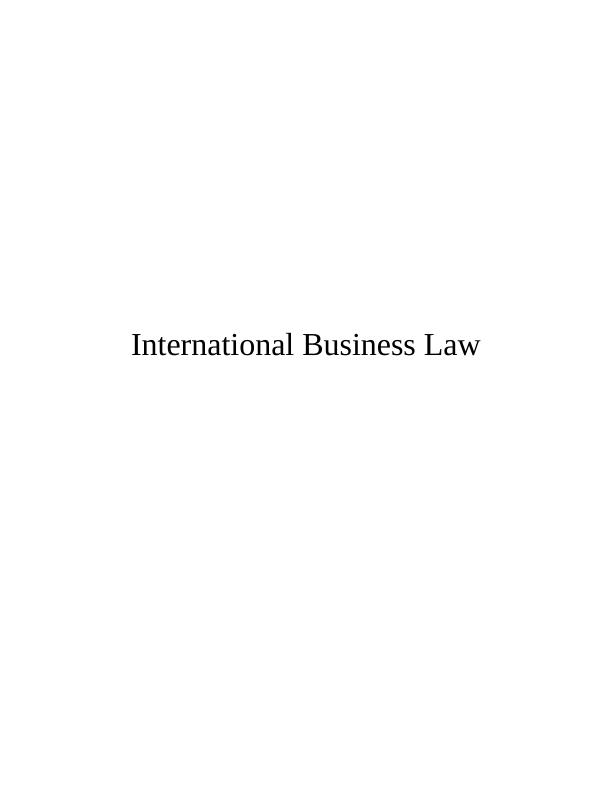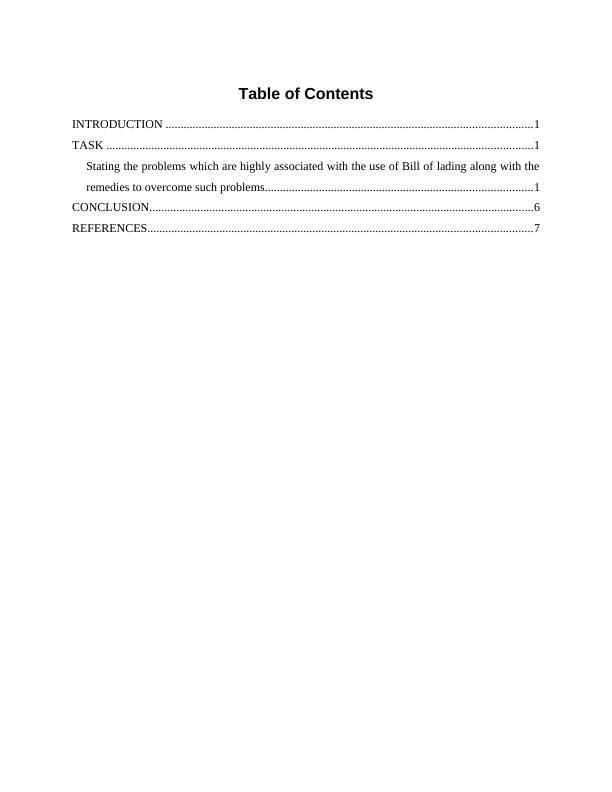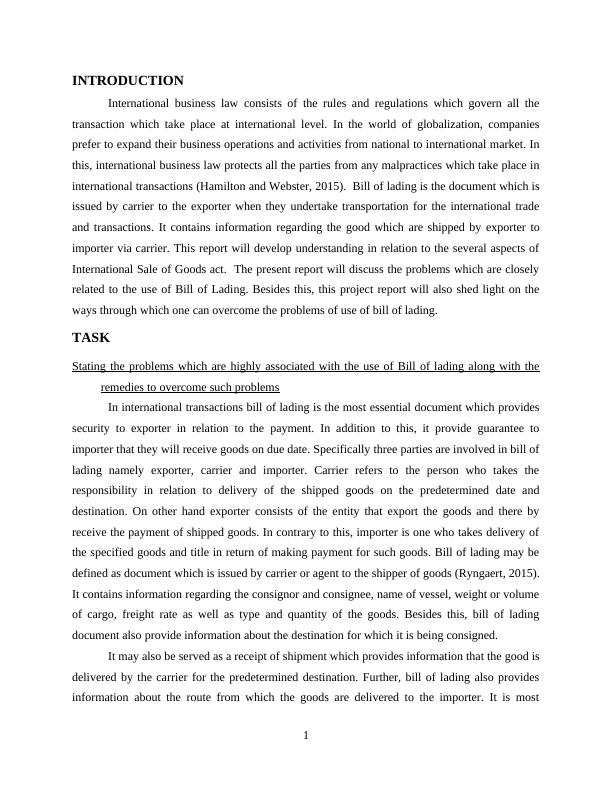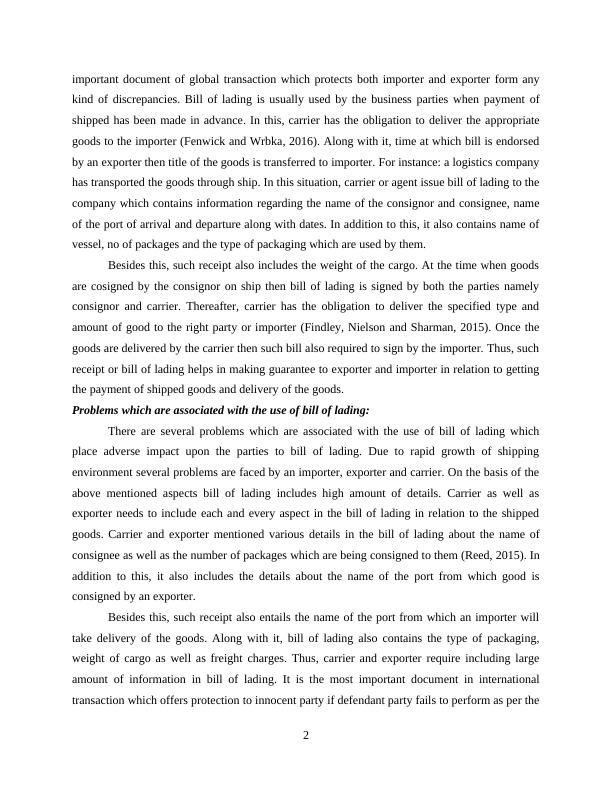Ask a question from expert
International Business Law | Introduction
11 Pages3523 Words195 Views
Added on 2019-12-28
International Business Law | Introduction
Added on 2019-12-28
BookmarkShareRelated Documents
International Business Law

Table of ContentsINTRODUCTION ..........................................................................................................................1TASK ..............................................................................................................................................1Stating the problems which are highly associated with the use of Bill of lading along with theremedies to overcome such problems.........................................................................................1CONCLUSION................................................................................................................................6REFERENCES................................................................................................................................7

INTRODUCTION International business law consists of the rules and regulations which govern all thetransaction which take place at international level. In the world of globalization, companiesprefer to expand their business operations and activities from national to international market. Inthis, international business law protects all the parties from any malpractices which take place ininternational transactions (Hamilton and Webster, 2015). Bill of lading is the document which isissued by carrier to the exporter when they undertake transportation for the international tradeand transactions. It contains information regarding the good which are shipped by exporter toimporter via carrier. This report will develop understanding in relation to the several aspects ofInternational Sale of Goods act. The present report will discuss the problems which are closelyrelated to the use of Bill of Lading. Besides this, this project report will also shed light on theways through which one can overcome the problems of use of bill of lading. TASK Stating the problems which are highly associated with the use of Bill of lading along with theremedies to overcome such problemsIn international transactions bill of lading is the most essential document which providessecurity to exporter in relation to the payment. In addition to this, it provide guarantee toimporter that they will receive goods on due date. Specifically three parties are involved in bill oflading namely exporter, carrier and importer. Carrier refers to the person who takes theresponsibility in relation to delivery of the shipped goods on the predetermined date anddestination. On other hand exporter consists of the entity that export the goods and there byreceive the payment of shipped goods. In contrary to this, importer is one who takes delivery ofthe specified goods and title in return of making payment for such goods. Bill of lading may bedefined as document which is issued by carrier or agent to the shipper of goods (Ryngaert, 2015).It contains information regarding the consignor and consignee, name of vessel, weight or volumeof cargo, freight rate as well as type and quantity of the goods. Besides this, bill of ladingdocument also provide information about the destination for which it is being consigned. It may also be served as a receipt of shipment which provides information that the good isdelivered by the carrier for the predetermined destination. Further, bill of lading also providesinformation about the route from which the goods are delivered to the importer. It is most1

important document of global transaction which protects both importer and exporter form anykind of discrepancies. Bill of lading is usually used by the business parties when payment ofshipped has been made in advance. In this, carrier has the obligation to deliver the appropriategoods to the importer (Fenwick and Wrbka, 2016). Along with it, time at which bill is endorsedby an exporter then title of the goods is transferred to importer. For instance: a logistics companyhas transported the goods through ship. In this situation, carrier or agent issue bill of lading to thecompany which contains information regarding the name of the consignor and consignee, nameof the port of arrival and departure along with dates. In addition to this, it also contains name ofvessel, no of packages and the type of packaging which are used by them. Besides this, such receipt also includes the weight of the cargo. At the time when goodsare cosigned by the consignor on ship then bill of lading is signed by both the parties namelyconsignor and carrier. Thereafter, carrier has the obligation to deliver the specified type andamount of good to the right party or importer (Findley, Nielson and Sharman, 2015). Once thegoods are delivered by the carrier then such bill also required to sign by the importer. Thus, suchreceipt or bill of lading helps in making guarantee to exporter and importer in relation to gettingthe payment of shipped goods and delivery of the goods.Problems which are associated with the use of bill of lading:There are several problems which are associated with the use of bill of lading whichplace adverse impact upon the parties to bill of lading. Due to rapid growth of shippingenvironment several problems are faced by an importer, exporter and carrier. On the basis of theabove mentioned aspects bill of lading includes high amount of details. Carrier as well asexporter needs to include each and every aspect in the bill of lading in relation to the shippedgoods. Carrier and exporter mentioned various details in the bill of lading about the name ofconsignee as well as the number of packages which are being consigned to them (Reed, 2015). Inaddition to this, it also includes the details about the name of the port from which good isconsigned by an exporter. Besides this, such receipt also entails the name of the port from which an importer willtake delivery of the goods. Along with it, bill of lading also contains the type of packaging,weight of cargo as well as freight charges. Thus, carrier and exporter require including largeamount of information in bill of lading. It is the most important document in internationaltransaction which offers protection to innocent party if defendant party fails to perform as per the2

End of preview
Want to access all the pages? Upload your documents or become a member.
Related Documents
International Business - Assignment Samplelg...
|16
|3644
|64
Canadian Customs Documentation Ruleslg...
|14
|2078
|492
Assignment Maritime Law Essaylg...
|12
|3814
|53
Shipper-Carrier Obligations- International Laws and Agreementlg...
|8
|2231
|30
International Trade Law Assignmentlg...
|10
|2174
|51
Seller of Goods Lims Lorries Ltdlg...
|14
|3649
|33